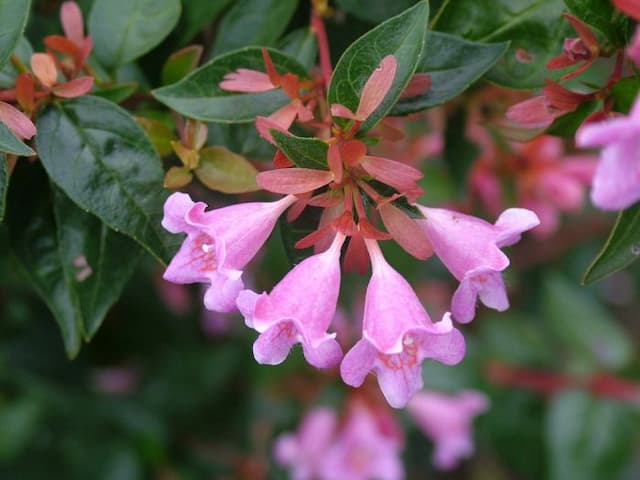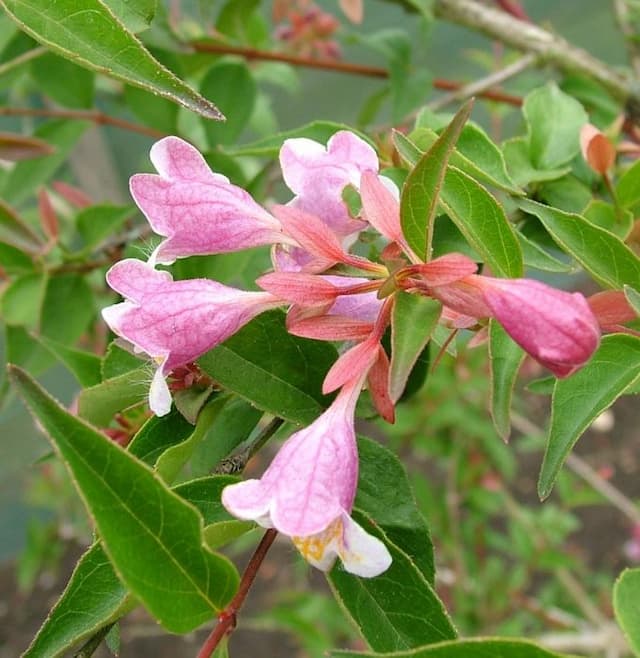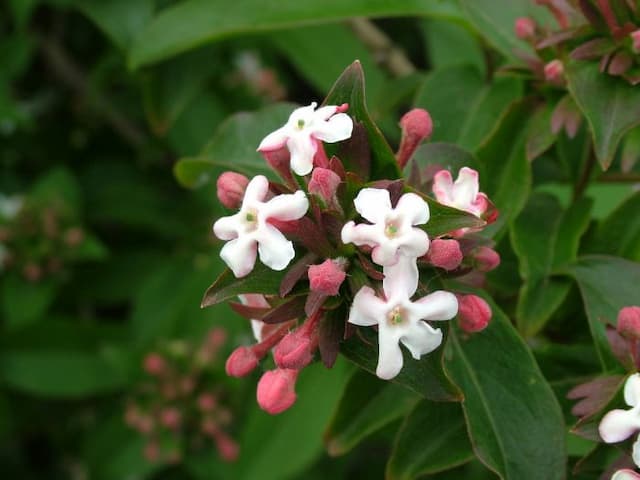Weigela Weigela Black and White = 'Courtacad1' (PBR)
![weigela [Black and White]](/_next/image?url=https%3A%2F%2Fplants-admin.emdemapps.com%2Fimages%2Fplants%2F%2Fimages%2F607ea47f7be8a.jpg&w=3840&q=75)
ABOUT
Weigela Black and White, commonly known as Weigela, is an ornamental shrub that boasts a stunning contrast between its flower and foliage colors. It features deep burgundy to almost black leaves, which create a dramatic backdrop for the profuse white trumpet-shaped flowers that bloom. The flowers are a magnet for pollinators such as bees and hummingbirds, adding a lively element to the garden when it is in bloom. When not in flower, the dark foliage provides a striking contrast against the brighter greens typically found in a garden landscape. The Weigela Black and White is appreciated for its seasonal visual interest, with the lushness of the leaves and the purity of the blooms offering a captivating display.
About this plant
 Names
NamesFamily
Caprifoliaceae.
Synonyms
Weigela 'Black and White', Black and White Weigela.
Common names
Weigela 'Courtacad1' (PBR)
 Toxicity
ToxicityTo humans
The Weigela plant does not generally contain toxic substances that are harmful to humans. If you were to ingest parts of this plant, it is unlikely to cause poisoning or severe symptoms. However, as with any non-food plant, individual sensitivities can vary and mild stomach upset or an allergic reaction cannot be completely ruled out if ingested or handled.
To pets
The Weigela plant is generally considered non-toxic to pets including cats and dogs. If your pet were to consume parts of this plant, they're unlikely to experience serious symptoms of poisoning. Nevertheless, ingestion of non-dietary foliage can sometimes lead to gastrointestinal discomfort, like vomiting or diarrhea, so it is still best to prevent pets from chewing on it extensively.
 Characteristics
CharacteristicsLife cycle
Perennials
Foliage type
Deciduous
Color of leaves
Green
Flower color
White
Height
3 feet (0.91 meters)
Spread
3 feet (0.91 meters)
Plant type
Shrub
Hardiness zones
5
Native area
Asia
Benefits
 General Benefits
General Benefits- Attractive Foliage: The Weigela Black and White has striking dark purplish-black leaves, making it a standout plant for visual interest.
- Showy Flowers: It produces contrasting white flowers that add beauty and appeal to any garden setting.
- Pollinator Friendly: The flowers attract bees, butterflies, and other beneficial pollinators, encouraging a healthy ecosystem.
- Low Maintenance: This plant is known for being easy to care for with minimal pruning and watering requirements once established.
- Drought Tolerance: It has the ability to withstand periods of drought once fully established, making it suitable for xeriscaping.
- Versatile Landscaping: The Weigela Black and White can be used in various landscaping designs, including borders, foundations, and as a specimen plant.
- Long Blooming Period: This plant typically has a long blooming season, providing color and interest for an extended period.
- Seasonal Interest: The foliage and structure offer aesthetic appeal throughout multiple seasons.
 Medical Properties
Medical PropertiesThis plant is not used for medical purposes.
 Air-purifying Qualities
Air-purifying QualitiesThis plant is not specifically known for air purifying qualities.
 Other Uses
Other Uses- Weigela Black and White is a striking ornamental plant for themed gardens, especially monochromatic or black and white gardens.
- The contrasting foliage can be used to create dramatic backdrops in photography, especially in macro botanical photography.
- Cut branches of Weigela Black and White can be placed in vases for indoor decoration, providing a unique and bold aesthetic.
- The resilient nature of this Weigela cultivar allows it to be used in urban landscaping, tolerating some levels of pollution.
- Its dense foliage can serve as a natural privacy screen or hedge in residential gardens without the need for frequent trimming.
- Weigela Black and White can be used in educational settings like schools or botanical labs to demonstrate plant breeding and hybridization.
- This plant's non-invasive root system makes it ideal for planting near structures like patios and paths, reducing the risk of damage.
- As a low maintenance plant, Weigela Black and White is suitable for novice gardeners who wish to add unique color to their outdoor space.
- The plant can be used in sensory gardens, as the dark leaves contrast with brighter flowers and foliage, stimulating sight.
- Weigela Black and White's sturdy stems make it suitable for supporting smaller, climbing plants that may require a living trellis.
Interesting Facts
 Feng Shui
Feng ShuiThe Weigela is not used in Feng Shui practice.
 Zodiac Sign Compitability
Zodiac Sign CompitabilityThe Weigela is not used in astrology practice.
 Plant Symbolism
Plant Symbolism- Contrast and Balance: The Weigela Black and White's distinctive coloring of dark foliage and white flowers symbolizes the beauty of contrast and the harmony of opposites.
- Adaptation: This plant's ability to adapt to various growing conditions may symbolize flexibility and the capacity to thrive in different environments.
- Renewal: The Weigela blooms in late spring, suggesting themes of rebirth and new beginnings associated with this season.
- Endurance: Weigelas are hardy shrubs that can withstand different climates, often representing resilience and toughness.
- Attraction: With its striking appearance and appealing flowers, the Weigela can symbolize attraction and the power of drawing in positivity or admiration.
 Water
WaterThe Weigela, commonly known as Weigela 'Black and White', should be watered deeply to promote root growth, ensuring that the soil is moist but not waterlogged. During the active growing season in spring and summer, it typically requires watering once a week, with about one gallon of water per plant. In the fall and winter, reduce watering frequency to every two to three weeks, or as needed, depending on weather conditions and soil moisture levels. It's important to adjust watering based on rainfall, ideally by checking the soil moisture before watering to prevent overwatering.
 Light
LightThe Weigela 'Black and White' thrives in full sun to partial shade conditions. It performs best when it receives at least 6 hours of sunlight a day, so planting it in a location where it can enjoy morning sun with some afternoon shade is ideal. Too little light can reduce flowering, so make sure it has access to ample sunshine for optimal growth and blooming.
 Temperature
TemperatureThe Weigela 'Black and White' is hardy and can survive in temperatures as low as -20°F and as high as 90°F, although it prefers a range of 50°F to 75°F for ideal growth. It is important to shelter the plant from extreme cold by mulching around the base and provide some protection from harsh winds that can cause damage to the foliage and stems.
 Pruning
PruningPruning Weigela 'Black and White' is necessary to maintain its shape, remove dead or crossed branches, and encourage robust new growth and plentiful blooms. The best time to prune is immediately after the spring flowering period, as the plant blooms on old wood. Prune selectively, removing up to one-third of the oldest stems, and shape as desired. Yearly pruning will keep the plant vigorous and attractive.
 Cleaning
CleaningAs needed
 Soil
SoilWeigela 'Black and White' thrives in well-drained, fertile soil with a pH range of 5.5 to 7.5. An ideal soil mix can be achieved by combining loamy garden soil with compost and peat moss, which helps with drainage and fertility. Mulching is beneficial to retain soil moisture and regulate temperature.
 Repotting
RepottingWeigela 'Black and White' typically does not need to be repotted often as it is primarily grown outdoors. It is a shrub and is best transplanted or repotted only when necessary, such as when it outgrows its current location, which could be several years apart.
 Humidity & Misting
Humidity & MistingWeigela 'Black and White' is adaptable to a wide range of outdoor humidity conditions. It does not require any specific humidity level, making it suitable for most temperate climates as long as it is planted in well-draining soil.
 Suitable locations
Suitable locationsIndoor
Provide bright light and avoid waterlogging for indoor Weigela 'Black and White'.
Outdoor
Full sun to partial shade and well-draining soil for outdoor Weigela 'Black and White'.
Hardiness zone
4-8 USDA
 Life cycle
Life cycleThe life cycle of Weigela 'Black and White' (botanical name: Weigela florida 'Courtacad1') begins with germination, where the plant sprouts from seeds under favorable conditions of moisture and temperature. The seedling stage follows, where it develops roots and the first set of true leaves, relying on the nutrients stored in the seed. As it enters the vegetative stage, Weigela 'Black and White' experiences rapid growth, establishing a more extensive root system and producing more leaves, leading to the formation of a bushy shrub. The next significant phase is the flowering stage, typically occurring in late spring to early summer, where it produces contrasting white flowers against dark foliage. After pollination, if successful, the plant enters the fruiting stage where seeds develop and mature, eventually being dispersed by various means such as wind, animals, or gravity. Finally, in its maturity stage, the Weigela 'Black and White' maintains its size, continues to flower annually, and may eventually undergo senescence, where growth slows and the plant may die back, completing its life cycle.
 Propogation
PropogationPropogation time
Spring to Summer
The Weigela 'Black and White', known botanically as Weigela florida 'Courtacad1' (PBR), can be propagated through semi-hardwood cuttings typically during late spring or early summer. For this method, strong, healthy shoots are selected. From these shoots, cuttings about 4 to 6 inches (10-15 cm) long are taken, each having several leaves. The lower leaves are removed, and the cut end may be dipped in a rooting hormone to encourage root development. The cuttings are then inserted into a well-draining potting mix, ensuring that at least one or two nodes are buried where the leaf joints are. The pot should be covered with a plastic bag or placed in a propagator to maintain high humidity around the cuttings. It usually takes a few weeks for roots to develop, after which the new plants can be gradually acclimatized to outdoor conditions and then planted out in their final position.








![Himalayan honeysuckle [Golden Lanterns]](/_next/image?url=https%3A%2F%2Fplants-admin.emdemapps.com%2Fimages%2Fplants%2F%2Fimages%2F604b55302cc87.png&w=640&q=75)
